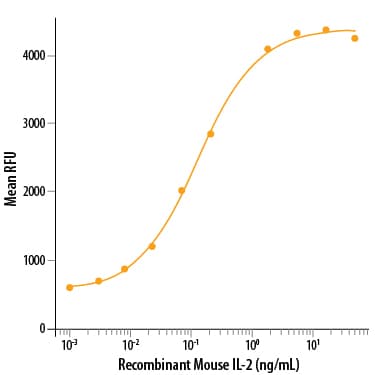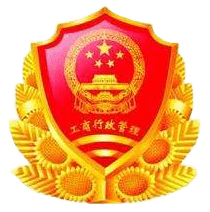



 下载产品说明书
下载产品说明书 下载SDS
下载SDS 用小程序,查商品更便捷
用小程序,查商品更便捷



 收藏
收藏
 对比
对比 咨询
咨询Scientific Data
 View Larger
View LargerRecombinant Mouse IL-2 (Catalog # 402-ML) stimulates cell proliferation of the CTLL-2 mouse cytotoxic T cell line. The ED50 for this effect is 0.1-0.4 ng/mL.
 View Larger
View Larger1 μg/lane of Recombinant Mouse IL-2 was resolved with SDS-PAGE under reducing (R) conditions and visualized by silver staining, showing a band(s) at 19 kDa.
Carrier Free
CF stands for Carrier Free (CF). We typically add Bovine Serum Albumin (BSA) as a carrier protein to our recombinant proteins. Adding a carrier protein enhances protein stability, increases shelf-life, and allows the recombinant protein to be stored at a more dilute concentration. The carrier free version does not contain BSA.
In general, we advise purchasing the recombinant protein with BSA for use in cell or tissue culture, or as an ELISA standard. In contrast, the carrier free protein is recommended for applications, in which the presence of BSA could interfere.
402-ML
| Formulation | Lyophilized from a 0.2 μm filtered solution in Sodium Citrate and Tween®-80 with BSA as a carrier protein. |
| Reconstitution | Reconstitute at 100-200 μg/mL in sterile PBS containing at least 0.1% human or bovine serum albumin. |
| Shipping | The product is shipped at ambient temperature. Upon receipt, store it immediately at the temperature recommended below. |
| Stability & Storage: | Use a manual defrost freezer and avoid repeated freeze-thaw cycles.
|
402-ML/CF
| Formulation | Lyophilized from a 0.2 μm filtered solution in Sodium Citrate and Tween®-80. |
| Reconstitution | Reconstitute at 100-200 μg/mL in sterile deionized water. |
| Shipping | The product is shipped at ambient temperature. Upon receipt, store it immediately at the temperature recommended below. |
| Stability & Storage: | Use a manual defrost freezer and avoid repeated freeze-thaw cycles.
|
Recombinant Mouse IL-2 Protein Summary
Product Specifications
Ala21-Gln169, with and without an N-terminal Met
Analysis

Background: IL-2
Interleukin‑2 (IL‑2) is a O‑glycosylated four alpha ‑helix bundle cytokine that has potent stimulatory activity for antigen‑activated T cells. It is expressed by CD4+ and CD8+ T cells, gamma δ T cells, B cells, dendritic cells, and eosinophils (1‑3). Mature mouse IL‑2 shares 56% and 73% aa sequence identity with human and rat IL‑2, respectively. It shows strain‑specific heterogeneity in an N‑terminal region that contains a poly‑glutamine stretch (4). Mouse and human IL‑2 exhibit cross‑species activity (5). The receptor for IL‑2 consists of three subunits that are present on the cell surface in varying preformed complexes (6‑8). The 55 kDa IL‑2 R alpha is specific for IL‑2 and binds with low affinity. The 75 kDa IL‑2 R beta, which is also a component of the IL‑15 receptor, binds IL‑2 with intermediate affinity. The 64 kDa common gamma chain gamma c/IL-2 R gamma, which is shared with the receptors for IL‑4, ‑7, ‑9, ‑15, and ‑21, does not independently interact with IL‑2. Upon ligand binding, signal transduction is performed by both IL‑2 R beta and gamma c. IL‑2 is best known for its autocrine and paracrine activity on T cells. It drives resting T cells to proliferate and induces IL‑2 and IL‑2 R alpha synthesis (1, 2). It contributes to T cell homeostasis by promoting the Fas‑induced death of naïve CD4+ T cells but not activated CD4+ memory lymphocytes (9). IL‑2 plays a central role in the expansion and maintenance of regulatory T cells, although it inhibits the development of Th17 polarized cells (10‑12). Thus, IL‑2 may be a key cytokine in the natural suppression of autoimmunity (13, 14).
- Ma, A. et al. (2006) Annu. Rev. Immunol. 24:657.
- Gaffen, S.L. and K.D. Liu (2004) Cytokine 28:109.
- Kashima, N. et al. (1985) Nature 313:402.
- Matesanz, F. et al. (1993) Immunogenetics 38:300.
- Mosmann, T.R. et al. (1987) J. Immunol. 138:1813.
- Liparoto, S.F. et al. (2002) Biochemistry 41:2543.
- Wang, X. et al. (2005) Science 310:1159.
- Bodnar, A. et al. (2008) Immunol. Lett. 116:117.
- Jaleco, S. et al. (2003) J. Immunol. 171:61.
- Malek, T.R. (2003) J. Leukoc. Biol. 74:961.
- Laurence, A. et al. (2007) Immunity 26:371.
- Kryczek, I. et al. (2007) J. Immunol. 178:6730.
- Afzali, B. et al. (2007) Clin. Exp. Immunol. 148:32.
- Fehervari, Z. et al. (2006) Trends Immunol. 27:109.


参考图片
Recombinant Mouse IL-2 (Catalog # 402‑ML) stimulates cell proliferation of the CTLL‑2 mouse cytotoxic T cell line. The ED50 for this effect is typically 0.1‑0.4 ng/mL.
1 μg/lane of Recombinant Mouse IL-2 was resolved with SDS-PAGE under reducing (R) conditions and visualized by silver staining, showing a band(s) at 19 kDa.






 危险品化学品经营许可证(不带存储) 许可证编号:沪(杨)应急管危经许[2022]202944(QY)
危险品化学品经营许可证(不带存储) 许可证编号:沪(杨)应急管危经许[2022]202944(QY)  营业执照(三证合一)
营业执照(三证合一)